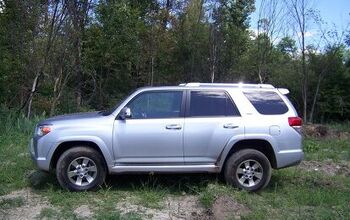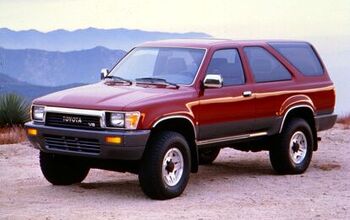Ace of Base: 2017 Toyota 4Runner SR5

A great advantage to being one of the world’s largest automakers is that one can afford to wait for a bet to pay off. Witness this body-on-frame fifth-generation 4Runner, introduced to an apathetic and SUV-adverse public in the dark days of the 2009 as a ’10 model. It is still sharing showroom space with Corollas and Camrys today. Contrast this to Kia that introduced its body-on-frame SUV – the Borrego – at around the same time. It landed in the market with a dull thud and quickly resigned itself to the automotive dustbin of history in North America.
The 4Runner’s fortunes are on the upswing assisted by consumers consuming SUVs with all the restraint of a record producer with a garbage bag full of cocaine and a garden hose. Toyota sold more 4Runners in 2016 than at any other time in the last dozen years despite the brand’s glacier-like design cycle and the 4Runner being largely unchanged since the turn of the decade.
Back then, Toyota offered the 4Runner with a 157 horsepower inline-four, which must’ve accelerated at the pace of continental drift tasked with carting around two tons of body-on-frame SUV. Today’s shoppers will find a 24-valve 4.0-liter V6 making 270 hp as the 4Runner’s sole engine offering. Four-wheel drive is a $2,220 option, but Toyota sees fit to pack a limited-slip diff into the rear axle of 4Runners whose power is sent only astern. A gnarly 30-degree approach angle (hello, Ford Raptor) and 9 inches of ground clearance promise off-road chops so long as the Ace of Base customer remembers they only have a brace of driven wheels. Quarter-inch skid plates lurk under the chassis.
Yes, I poked fun at the age of this thing, but the design has worn well in these jaundiced eyes, showing off a rugged stance likely to frighten the two-tone paint off its youthful C-HR cousin. Economies of scale make sure the cheapest of Runners come equipped with projector beam headlamps and LED rear lamps, just like the fancy TRD and Limited models. Every 4Runner is shod with 265/70R17 meats.
Air conditioning with vents for rear passengers, natty power-sliding liftgate window (just like the Bronco, Mark!), and backup camera are all present and accounted for, as they should be for a sticker of $33,710. Nearly 90 cubic feet of cargo space greet household movers and kitchen cabinet builders when they fold down the rear seats. A third row is optional. You don’t need it. A quintet of 12-volt ports keeps all hands empowered, with a 120-volt outlet and a USB port tossed in for good measure.
Toyota’s Entune system with a 6.1-inch screen, satellite radio, and eight speakers shows up in the base 4Runner, with wireless-this and handsfree-that taking charge of the tunes and calls. Sadly, the killjoys at Toyota seemed to have deep-sixed the Party Mode button a couple of years ago.
It’s worth noting a base 2WD 4Runner is only $1,215 dearer than a loaded 2WD CR-V, or — staying in the same showroom — $1,040 less than a 2WD top-of-range RAV4. Viewed through that lens, I can suddenly understand the 4Runner’s increased sales numbers.
Loaded jellybean soft-roader or base body-on-frame bruiser? For roughly the same cheddar, I know which one I’d choose. How about you?
Not every base model has aced it. The ones that have? They help make the automotive landscape a lot better. Any others you can think of, B&B? Let us know in the comments. Naturally, feel free to eviscerate our selections.
The model above is shown with American options and is priced in Freedom Dollars absent of delivery and other fees. As always, your dealer may sell for less. Unless they’re selling a lot of them, in which case they probably won’t.

Matthew buys, sells, fixes, & races cars. As a human index of auto & auction knowledge, he is fond of making money and offering loud opinions.
More by Matthew Guy
Latest Car Reviews
Read moreLatest Product Reviews
Read moreRecent Comments
- SCE to AUX All that lift makes for an easy rollover of your $70k truck.
- SCE to AUX My son cross-shopped the RAV4 and Model Y, then bought the Y. To their surprise, they hated the RAV4.
- SCE to AUX I'm already driving the cheap EV (19 Ioniq EV).$30k MSRP in late 2018, $23k after subsidy at lease (no tax hassle)$549/year insurance$40 in electricity to drive 1000 miles/month66k miles, no range lossAffordable 16" tiresVirtually no maintenance expensesHyundai (for example) has dramatically cut prices on their EVs, so you can get a 361-mile Ioniq 6 in the high 30s right now.But ask me if I'd go to the Subaru brand if one was affordable, and the answer is no.
- David Murilee Martin, These Toyota Vans were absolute garbage. As the labor even basic service cost 400% as much as servicing a VW Vanagon or American minivan. A skilled Toyota tech would take about 2.5 hours just to change the air cleaner. Also they also broke often, as they overheated and warped the engine and boiled the automatic transmission...
- Marcr My wife and I mostly work from home (or use public transit), the kid is grown, and we no longer do road trips of more than 150 miles or so. Our one car mostly gets used for local errands and the occasional airport pickup. The first non-Tesla, non-Mini, non-Fiat, non-Kia/Hyundai, non-GM (I do have my biases) small fun-to-drive hatchback EV with 200+ mile range, instrument display behind the wheel where it belongs and actual knobs for oft-used functions for under $35K will get our money. What we really want is a proper 21st century equivalent of the original Honda Civic. The Volvo EX30 is close and may end up being the compromise choice.


































Comments
Join the conversation
WTH does Ace of Base mean?
My truck is the last year of the second generation, a 1995. I picked it up with nearly 200k miles 3 1/2 years ago. Since then I have tuned it and replaced a speedometer cable and 02 sensor. Everything on the truck works and the mileage is from 17 when in the pasture working on fence to 20 when on the highway pulling a trailer. Thanks to the big tire crowd the stock first gear is just about useless but it rides extremely well on the highway. I bought it for the 4wd and it would have been stuck in the pasture often enough to make it useless if not for that. I had heard bad things about the 3.0 engine but bought it figuring that by the last year they would have worked the bugs out with the head gasket. It seems they did. I know that if I had bought a year later I would have gotten a reportedly better engine and a land cruiser frame of some genre or other. However, this is what was available. It is less primitive than the first generation but still very much a truck. My wife certainly agrees with the commenter who mentioned the high floor boards. She cannot stand that and it certainly reduces the miles I drive it. Some recent play trips into the forest service roads of the nearby Sam Houston National Forest have convinced her that it has it’s place. Sometimes it is worth the uncomfortable ride. I make these comments to say that although my truck is somewhat old, the characteristics that make 4runners is pretty much the same. Texas requires smog inspections on vehicles till they are 26 years old and there will need to be some work done before the next one. It is OBD1 and there appears to be some work needed on the EGR system which I understand is inconvenient to reach. Assuming that I can slip thru the next three inspections this may be the last truck I need to buy. Being dependable and paid for works for me.